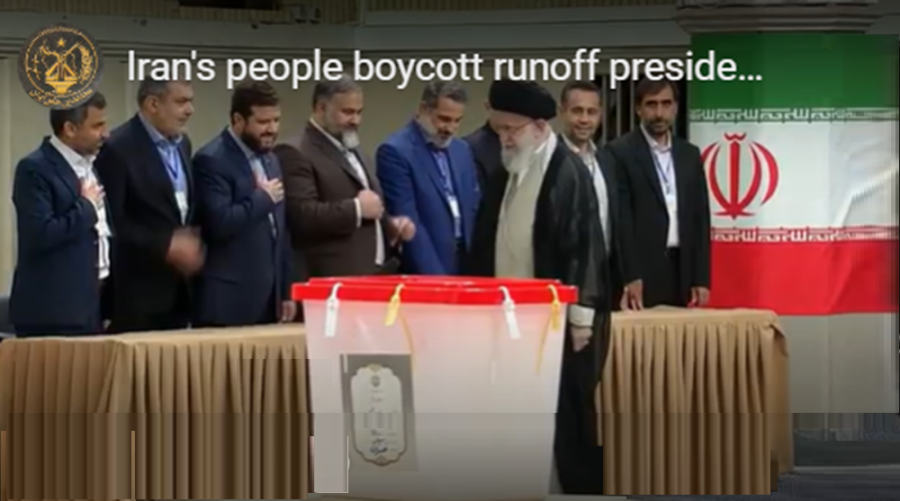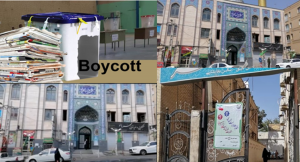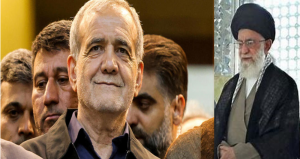
(Video) What the Iranian people want and what they don’t want
During the regime’s sham presidential elections on June 28, Ali Khamenei was forced to admit, “In the first stage, participation was less than we expected.”
PARIS, FRANCE, July 11, 2024 /EINPresswire.com/ -- The official website of the People’s Mojahedin Organization of Iran (PMOI/MEK) in an article published that the world saw two very contrasting pictures of the Iranian people and their desires within a week. On the one hand, were the first and second rounds of the Iranian regime’s sham presidential elections, held on June 28 and July 5, which were met with an unprecedented boycott by the Iranian people.
On the other hand, there was the Free Iran 2024 World Summit, held on June 29–July 1 in France and Germany, which was welcomed by Iranians worldwide and supported by politicians, jurists, and activists.
What we don’t want
On June 28, at the ballot box, Iranian regime supreme leader Ali Khamenei, once again begged the people to participate in the elections, saying, “People should not hesitate to participate in the elections.
The survival, strength, dignity, and reputation of the Islamic Republic in the world depend on the people’s presence.” A few days earlier, he reiterated the connection between the elections and the future of his regime in a different way, stating, “If high participation is observed in these elections, it will bring pride to the Islamic Republic.”
However, on the election day, the Iranian people completely boycotted Khamenei’s show. From the early morning hours, reporters from Simay-e Azadi monitored polling stations and broadcasted the news of empty polling stations to the world.
On June 29, the Iran Watch news website quoted Ali Rabiei, a security official and promoter of one of the candidates, as saying, “The decline in participation compared to 2021 shows that the lower and middle classes are fed up.” Abbas Ahmad Akhoundi, Minister of Housing in former president Hassan Rouhani’s tenure (2013-2021), wrote on Twitter, “Sixty percent of eligible voters did not participate in the elections. Their message was clear.”
Heshmatollah Falahatpisheh, the former head of the security commission of Majlis (parliament), considered the low turnout natural and said, “The low participation level did not surprise me!”
Hesamodin Ashna, Rouhani’s advisor, said, “When for 35 years you have constantly hammered that the president is powerless, why do you expect high participation?” Even religious scholars raised their voices, noting that despite all the regime’s efforts, the people “did not accept” and rejected it.
The situation escalated to the point where the state-run Farhikhtegan newspaper by highlighting fear of the “danger” of an uprising and the “super crisis” of the regime caused by the younger generation, wrote, “I warn that intergenerational trauma, communication breakdown, public opinion inversion, the spread of criticism to indifference and even resentment in Generation Z, distrust or insufficient trust and hope, and economic problems are the super dangers facing the country; if ignored or not addressed, they will turn into super crises shortly.”
According to reports by the network of the PMOI, 88% of eligible voters boycotted the elections and refused to cast a ballot in favor of any of the candidates. This was, in fact, a referendum on the regime in its entirety, and the people definitively voted “no” to the regime.
The regime engaged in extensive efforts to rally people to the polling stations for the second round of the elections, which was held one week later on July 5.
Khamenei, who had decided to restore his regime’s “honor” and cover up his double defeat in the second round by inflating the number of participants through fraud and figure manipulation, shamelessly began laying the groundwork at the start of the voting and claimed that this time the level of “people’s enthusiasm and interest” would be higher than before.
However, this time around, the boycott was even more humiliating, with 91% of the people refusing to vote for the regime’s candidates.
What we want
In 1979, the people of Iran knew they did not want the Shah dictatorship. But they did not know what they wanted instead, and there was no national solidarity for a democratic republic based on the separation of religion and state. Ruhollah Khomeini exploited this atmosphere of ambiguity and confusion and, with backdoor deals, stole the people’s revolution.
But now, after nearly half a century of suffering and torment, this has relatively occurred: A pioneering organization and a popular resistance exist as an alternative, which has both international recognition and a clear, declared program.
An alternative that, just one day after the decisive boycott of the regime’s sham election, demonstrated 20,000 instances of the people’s desires with video messages from PMOI Resistance Units, sent from inside Iran with high risks to their safety and lives. Their unanimous message was that the people of Iran want regime change and support a democratic republic.
The presence of dozens of personalities, parliamentarians, politicians, and former leaders at the great resistance gathering in Paris demonstrated the recognition and credibility of the regime’s alternative.
The large demonstration in Berlin also revealed another positive aspect of the Iranian people’s demands.
The future of Iran
Unlike in the past, when every social change and even the greatest revolutions in Iran were hijacked and suppressed due to the lack of a competent leading body, this time the Iranian people, at the peak of their awareness and after several nationwide uprisings, know both what they want and what they don’t want.
In practice, they also have a pioneering organization consisting of thousands of professional members, with a clear and declared program that has an answer for every question and has outlined a clear vision in every field; a program for the future of Iran that dozens and hundreds of prominent political and legal figures have endorsed, including the Free Iran 2024 World Summit:
“The Iranian people are engaged in a struggle for democratic change, and we, all of us, should support them in that aim,” said David Jones, Former Minister and Member of the UK House of Commons, at the Summit.
“The future of Iran must be determined by the people of Iran who very clearly want a Democratic Republic, and that will only be achieved through an organized democratic resistance movement exemplified by Madam Rajavi and the National Council of Resistance of Iran – (NCRI).”
John Bercow, Former Speaker of the UK House of Commons, said, “The philosophy and the intended policy program of the National Council of Resistance of Iran is one of the most eloquent, articulate, and comprehensive statements of an alternative that any democrat could wish to see."
Fake votes and pretender reformists won’t save Khamenei’s regime.
Five days after Iran’s people massively boycotted the first round of the regime’s sham presidential elections on June 28, Supreme Leader Ali Khamenei was forced to admit, “In the first stage, participation was less than we expected,” and added dismissively, “If anyone thinks those who did not vote did so because they opposed the system, this understanding is completely wrong.” He then openly laid the groundwork for fraud and manipulation, promising higher participation in the second round.
The desperate supreme leader, despite repeated pleas and requests, faced a 91% boycott in the second round. He ridiculously combined the fraudulent votes from both rounds and claimed, “The people came out they filled the ballot boxes with over 55 million votes in two stages! This great movement, in confronting the artificial uproar of the election boycott created by the enemies of the Iranian nation to instill despair and deadlock, is a brilliant and unforgettable work.”
In these statements, the impact of the boycott’s hammer-like blow to the regime is evident. In his confusion from this blow, Khamenei vividly demonstrated how deeply he is burned and tormented by the “uproar of the boycott” and how troubled he is by the “despair and deadlock” that this boycott has cast over the entire regime.
Indeed, the “brilliant and unforgettable work” is his creation, combining the manipulated results of the two elections, a task usually performed by the
Ministry of the Interior with a host of aides.
This act, unprecedented in the history of fraudulent elections worldwide, turned two defeats one admitted to just a week earlier into a 55 million-vote victory. This is the art of reframing defeat and disgrace into victory.
Despite all this posturing, Khamenei could not hide two major concerns and fears in his message.
First, knowing that his broken regime is entering a new phase of turmoil and crisis today, he reminded the latest appointee, the self-proclaimed “reformist” Massoud Pezeshkian, to “continue Raisi’s path” and added, “Make the most of the country’s vast resources, especially the young and revolutionary human resources.”
This means that Ebrahim Raisi’s successor is not only required to continue Raisi’s path of maximum contraction, repression, execution, plunder, and pillage but also to use the “young and revolutionary human resources,” referring to Raisi’s government, which Khamenei called the “young and Hezbollah” and “revolutionary” government.
These descriptions apply only to those who are his absolute obedient followers. Three days before the first round of the sham election, Khamenei had sternly advised the “candidates” that “if you succeed and can get a position, do not choose your people and officials from those who have even the slightest deviation from the revolution [meaning the Supreme Leader] anyone who has even the slightest deviation is not suitable for you” (June 25, 2024).
Second, although Pezeshkian has explicitly stated that he is fully loyal to the supreme leader, Khamenei is well aware of the reality behind these words. He knows that the infighting over power is the inevitable nature of his regime.
Thus, he “recommends” that the regime’s opposing factions “transform the competitive behaviors of the election period into friendly norms.” However, he knows well that when it comes to power and plunder, such recommendations are worthless, and the escalation of crisis and division is inevitable.
With Raisi’s downfall and the collapse of Khamenei’s dreams of consolidation, the regime is facing a new balance. This shows Khamenei’s deadlock and evokes the final stage of the Shah.
The impact has shaken the pillars of the regime. The regime is riddled with holes from within, and the wolves are tearing each other apart. At this point, not even a pretender reformist can save the crisis-riddled regime.
Who are the main winners and losers of sham presidential elections
The second round of the Iranian regime’s sham presidential election turned out to be nothing but a global scandal. From early morning, regime supreme leader Ali Khamenei, in utter desperation claimed he had heard that this time the “enthusiasm and interest of the people” would be higher than before and wished that “it would be so,” pinning his “happiness” on the probability of a high voter turnout.
In the first round of this so-called election, he had said that for the “continuation and dignity” of his regime, he needed the people’s votes and their inked fingers, lamenting that the turnout was “less than his expectation.”
An existential crisis
In addition to Khamenei, other leaders, officials, and members of the two ruling factions expressed their frustration and desperation over the decisive and fiery boycott of the election show.
Ali Younesi, Special Assistant to former President Hassan Rouhani, said, “Last week’s low turnout had an important message; the officials of the Islamic Republic received this message.”
Mohammad-Javad Azari Jahromi, Minister of Information and Communications Technology in the Rouhani administration, said, “Do not leave voting to the last moments; extending the voting hours is up to the election organizers.”
Mohammad Bagher Ghalibaf, Majlis (Parliament) Speaker, said, “We hope that the people, with their enthusiastic presence in the second round of the presidential election, will compensate for the low turnout in the previous round and correctly shape their future for the next four years.”
Former president Mohammad Khatami (1997-2005) said, “Everyone should participate in this decisive election with hope so that we do not regret it later.”
The commander of the IRGC Aerospace Force, Amir Ali Hajizadeh, said, “Voting is simple; people should come forward. Every vote is like a missile for the state.”
It couldn’t have been stated more bluntly that the issue is about the existence of the regime.
Mohammad Mohajeri, a journalist close to the principlist faction, said: “There is no time for doubt anymore; it’s a matter of existence or non-existence, and people will surely choose existence.” (Source: Chand Sanieh Telegram channel).
Falsified turnout figures agreed upon by both factions
Despite the significant and undeniable emptiness of the polling stations in the early hours of voting, this time both factions of the regime suddenly announced that the turnout in this round was higher than the previous one. This was a clear prelude to falsifying and manipulating the final statistics.
This bubble-making occurred while various tactics were employed to make the polling stations appear busy and to portray the election show as vibrant.
Bringing Afghan nationals and local individuals to the polling stations; approaching the families of prisoners and promising the release of their children if they participated in the election; forcing prisoners to vote; transporting and unloading Basij members and regime agents from one polling station to another by minibusses; militarizing cities and strategic points with the deployment of police, Islamic Revolutionary Guard Corps (IRGC) motor units, and plainclothes agents creating a threatening atmosphere to force the population to vote; threatening to fire certain employees if they did not vote; and depositing money by presidential candidate Saeed Jalili for social security retirees were some of these actions.
The main winners and losers
What happened on July 5, 2024, had two main winners and losers. The main winners were the people and the Iranian Resistance, who once again highlighted the red line of overthrow by decisively and universally boycotting Khamenei’s show.
It was proven that the majority of the Iranian people do not want religious fascism and its constituent factions, and they seek change not in the ridiculous games of this regime but in its complete overthrow.
The main losers were Khamenei and both factions of the regime, who sought to reduce the main polarization in Iranian society to a false polarization between reformists and hardliners. Once again, it became clear that, as Iran’s people have been chanting in their protests since December 2017, “the game is over.”
If you wish to receive the NCRI weekly Newsletter, please use the following link to subscribe: https://bit.ly/3SMgEla.
Shahin Gobadi
NCRI
+33 6 61 65 32 31
email us here
The regime engaged in extensive efforts to rally people to the polling stations for the second round of the elections, which was held one week later on July 5.
EIN Presswire does not exercise editorial control over third-party content provided, uploaded, published, or distributed by users of EIN Presswire. We are a distributor, not a publisher, of 3rd party content. Such content may contain the views, opinions, statements, offers, and other material of the respective users, suppliers, participants, or authors.






